
Understanding the difference between hair and fur can get confusing. Why? Because chemically they are the same thing. So where does the difference come from? Explore what hair and fur are, along with the differences between them.
What’s the Difference Between Hair and Fur?
When it comes to science, hair and fur are the same. They have the same chemical makeup. Both hair and fur are made up of keratin, which are proteins. It’s actually the same proteins you find in your fingernails. Seems strange that your fingernails and hair share chemical properties, but they do.
On a scientific level, you can’t find a difference between hair and fur. So why is one hair and one fur? That is an excellent question. To answer the hair vs. fur debate, you need to look at the types of hair, growth pattern, purpose, and texture.
What Makes Hair and Fur?
All fur is hair. Mind blown right? Actually, when it comes to looking at fur and hair, you are looking at two types of hair: ground hair and guard hair. Ground hair is thick short hair, while guard hair is fine longer hair. Mammals having both these types of hair are said to have fur. However, if an animal just has one layer, they are said to have hair.
Growth of Hair
Both ground and guard hair have a different hair growth cycle. This cycle has three different phases: anagen, catagen, and telogen. The difference between ground hair and guard hair is the anagen phase. In addition to ground hair growing in sync, the anagen phase is shorter. Therefore, it grows to a certain length and stops growing.
Guard hair, however, can stay in the anagen phase much longer. Therefore, it will need to be cut. This is why animals go to the groomer and humans to the fashion salon to get their hair under control.
Hair vs. Fur: Purpose
Another difference between fur and hair is the purpose. On mammals, fur is designed to be an insulator. It is shorter, coarser, and keeps them cold in the summer and warm in the winter. Additionally, fur is often shed.
Hair, on the other hand, is longer and softer. It can provide some protection against the elements but not to the extent of fur. Hair can also grow longer and be more fashionable. For example, humans style their hair, and horses get their hair braided.
A Look at Texture
Texture is relative when it comes to hair vs. fur because depending on the size of the animal, the texture will be slightly different. However, generally, fur is thicker and more dense than hair. While the follicle itself might be similar, the thickness of it makes all the difference. For example, dogs have a thick coat of fur that makes it nearly impossible to find their skin. However, the hair on humans is less densely packed together. For example, humans have hair covering their arms and legs, but it’s much different from the fur on a dog.
Whisker and Quills
Whiskers and quills are distinct types of hairs that are specific to animals. Quills are just enlarged hairs, but whiskers actually have sensory receptors within them. Therefore, dogs and cats use their whiskers as an aid to seeing in the dark.
Difference Between Fur and Wool
Now that you know the difference between hair and fur, it’s time to look at fur and wool. First of all, it’s all hair. However, wool is unique to sheep, llamas, and similar animals. Additionally, wool is a type of soft, fine, curly hair that just keeps growing. For example, you may have heard the stories of sheep that get away from the herd and are found with pounds of wool on them.
Knowing the Difference Between Fur vs. Hair
The difference between hair and fur is anything but clear. Why? Because they are the same thing. The difference comes from our perception of hair and fur. Now that you know a bit about hair and fur, you might want to explore basic types of animals and their characteristics.